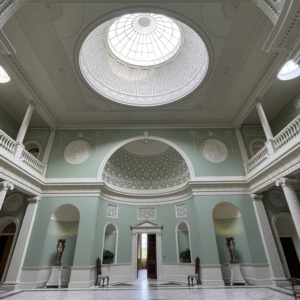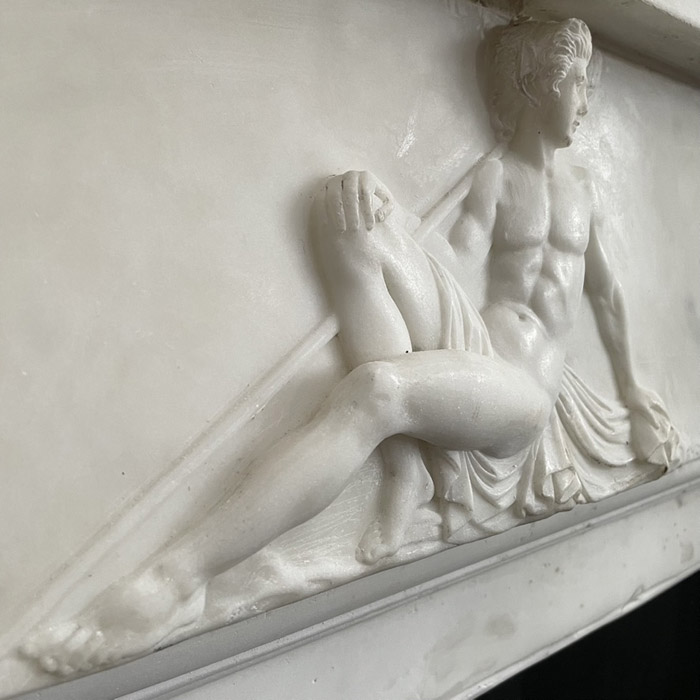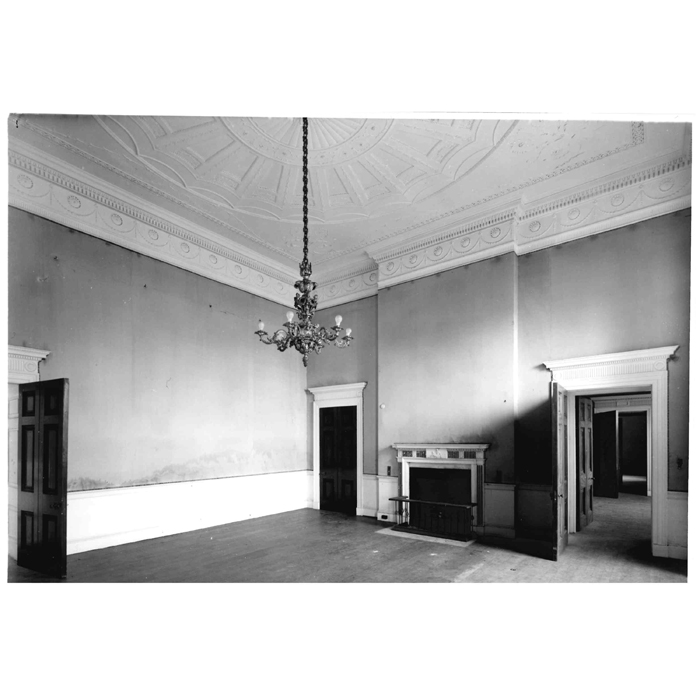No products in the basket.
A George III verde antica inlaid statuary marble chimneypiece
c.1775, in the manner of Robert Adam, removed from Charlton Park, Wiltshire, seat of the Earl of Suffolk, a Jacobean House remodelled in the 1770's by Matthew Brettingham the Younger (1725-1803)
the rectangular breakfront shelf, with inset corners and a beaded moulding, above the frieze with fluted inlay and oval patera and centred with a rectangular plaque carved in relief with a resting Baccante, the seated figure with his thyrsus angled on his shoulder, and flanked with end-blocks carved in relief with grape-filled urns, the jambs also inlaid with flutes and raised on block feet,
£33,200
In stock
Charlton Park is a large Country Estate in Wiltshire of around 4500acres – it has been the seat of the Earls of Suffolk since early in the 17th Century. John Dryden wrote “Annus Mirabilis” when a guest at the house in 1667.

Much later, in the 1770’s, under Henry Howard the 12th Earl, Matthew Brettingham the Younger (1725-1803) was engaged to radically improve and update the house.
Brettingham had spent most of his architectural career working for his father’s accomplished practice and, having based much of his early years in Rome receiving Grand Tourists in general and his father’s client Thomas Coke in particular (involved in the procurement of sculpture for Holkham) – Charlton remains one of only a few houses attributed solely to the younger Brettingham’s designs.

Brettingham operated in circles that saw him granted lucrative appointments such as “Deputy Revenue Collector of The Cinque Ports”. As Howard Colvin tactfully puts it, in reference to Brettingham’s occasional work after the death of his father in 1769, “the income derived from his sinecures seems largely to have relieved Brettingham from the need to develop an extensive architectural practice”.

His project saw the central courtyard roofed over and the hall and surrounding rooms transformed into a spectacular Georgian interior.


As with so many such houses – despite a restoration in the 1920’s, the middle six decades of the 20th Century saw a painful decline. However, the house was in the vanguard of a drive to re-invent delapidated country houses in the 1960’s and 70’s. In 1975, emulating the work of The Country Houses Association, Christopher Buxton formed “Period and Country Houses Ltd.” and inventively divided the grand house into separate residences which would meet the needs and budget of aspirational folk alongside the Earl who remained in residence. It saved the house but compromises were made. A series of photographs of the house prior to its conversion, and in a sorry state, show the empty interior as Buxton found it. The present fireplace, pictured therein, and now offered for sale was one of those compromises. LASSCO found it tucked in a dark cellar beneath an outbuilding on the estate where it had lain since these conversion works. It came from the suite of first floor rooms on the west side of the house.

The fireplace is a classic Georgian format – well proportion with a restrained elegance: smart Adam-style ornament with nicely executed inlay. The subject matter is rather good. Perhaps the young Dionysus, or more likely merely one of the retinue of Bacchus (note his human form but pointy elfin ears), is having a breather on a rock. (He doesn’t appear to be a “Satyr” as such – these are usually bearded and hairy and, later in classical image-making, are usually faun-like. He is certainly fit though – good musclature and great legs). His staff is a “Thyrsus” – a long spear with a cone on the end and always present in Bacchanalian hedonistic entourages. A thyrsus is a weapon, it conceals a spike; but often depicted dripping with honey it’s usually an un-subtle, often overt, phallic symbol. It is always there – essential to the cult. The wine, the angled thyrsus, the scantily clad Bacchante: this fireplace comes with slightly lewd undertones.










